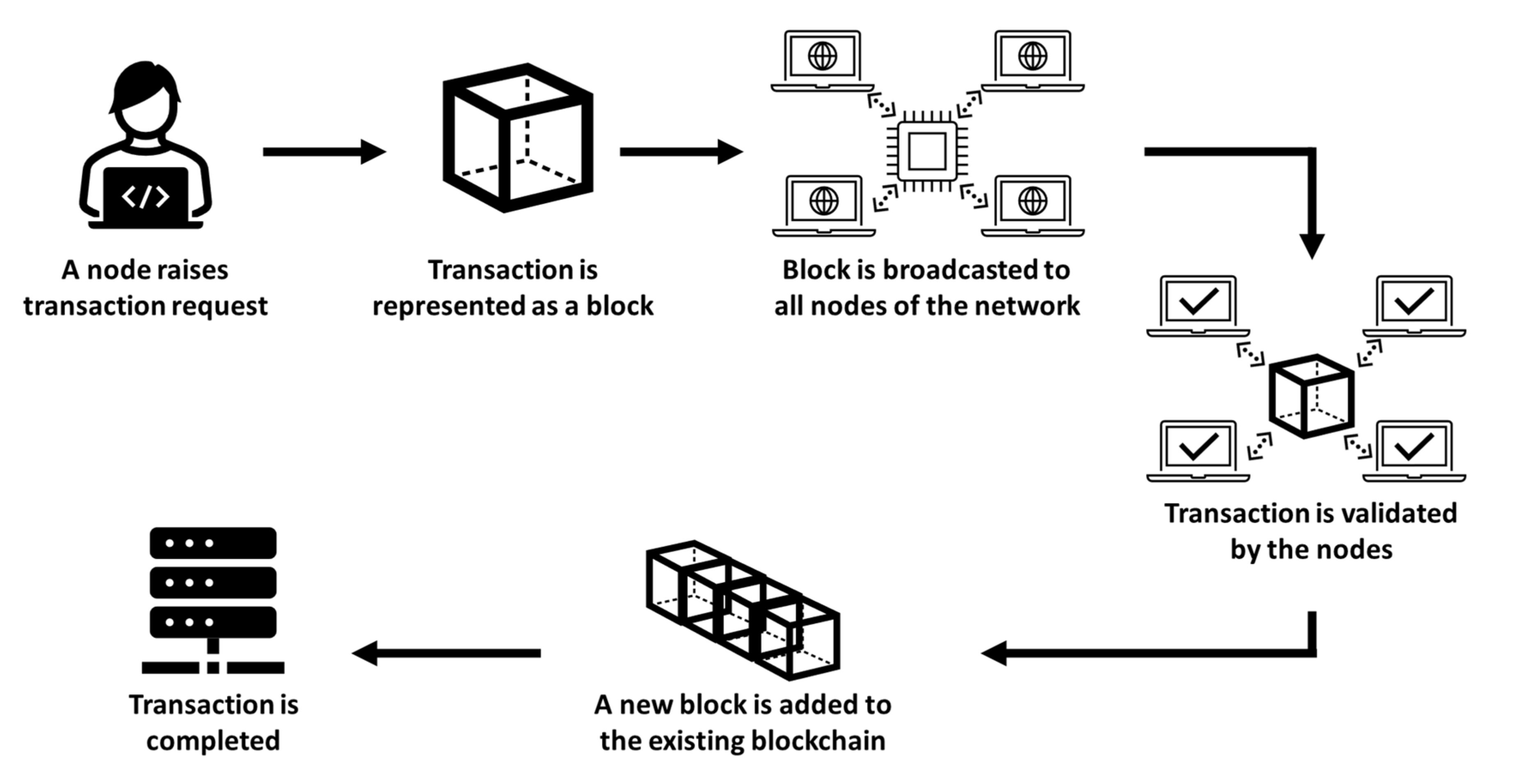
Photo by Pierre Borthiry - Peiobty on Unsplash
Unleashing the Power of Blockchain: A Comprehensive Guide
1️⃣Introduction:
💡What is Blockchain Technology?
A digital, decentralized ledger using blockchain technology keeps track of transactions transparently and securely. It consists of a growing list of blocks, each of which includes several transactions that have been confirmed and encrypted. To create a tamper-proof and immutable record of all transactions on the network, each block is connected to the one before it in the chain via a cryptographic hash. Without the use of middlemen or centrally controlled authorities, this decentralized structure enables a more efficient, secure, and transparent exchange of digital assets. Even though it was initially conceived for cryptocurrency, the technology is now used in a variety of fields, including supply chain management, healthcare, and real estate.
💡Importance of Blockchain in today's world:
👉Decentralization: Since blockchain technology relies on a decentralized network, no single entity is in charge of regulating transactions. As a result, the system is transparent, secure, and trustworthy.
👉Security: Blockchain technology is extremely safe and almost tamper-proof due to its cryptographic nature. This makes it the perfect option for situations where security is crucial, including financial transactions or medical records.
👉Transparency: The blockchain ledger's transparency means that every transaction is visible to every user on the network. This can encourage trust and responsibility by making it simpler to spot fraud or other negative behavior.
👉Efficiency: As there are no middlemen or third parties required for verification, blockchain technology offers quick and efficient transactions. This has the potential to lower costs and streamline procedures, especially in sectors where there are numerous parties to a transaction.
👉Innovation: Blockchain technology has the potential to revolutionize a variety of industries, including logistics, banking, and the medical field. It can create new business models and disrupt established sectors. It is already deployed for anything from smart contracts to digital identity management.
2️⃣How Blockchain Works:
💡The concept of a digital ledger
👉A database used to store and monitor digital transactions is known as a digital ledger. The ledger can be viewed as a collection of records, each of which contains data on a single transaction. A digital ledger, for instance, might document a transaction involving two parties, like the transfer of funds from one account to another.
👉Blockchain technology is based on the idea of a digital ledger. The ledger in a blockchain network is decentralized, which means that it is stored among various network nodes as opposed to being held by a single entity. Each node on the network keeps a copy of the ledger and takes part in updating it with new transactions and confirming the validity of existing ones.

👉Every time a new transaction is recorded in the ledger, it is validated by a decision-making procedure involving many network nodes. As soon as the transaction is approved, it is included in a fresh blockchain block. Each block is connected to the block before it is in the chain by a cryptographic hash and contains a set of validated transactions.
👉This produces an immutable and tamper-proof record of all network transactions that is accessible to and verifiable by every user. Blockchain technology's central component, the digital ledger, offers a secure and transparent means to track digital transactions.
💡The role of nodes in the blockchain network
👉A node is a participant in a blockchain network who keeps a copy of the blockchain ledger and aids in the validation and verification of transactions. The blockchain network's nodes are essential to its operation because they guarantee the ledger's accuracy and correctness.
👉A copy of the whole blockchain ledger is stored among the network's nodes in a decentralized fashion, and each node on the network has a copy of it. Each time a new transaction is started on the network, it is broadcast to every node for verification.
👉To validate a transaction and make sure it is valid, nodes employ sophisticated algorithms. This procedure normally includes verifying that the transaction is validly signed and that the sender has enough funds to finish the transaction. Following the transaction's verification, a new block is added to the blockchain and disseminated to all network nodes.
👉The security and integrity of the blockchain network are crucially maintained by nodes. Each node on the network has a copy of the full ledger due to its decentralized storage of the ledger, making it highly challenging for any one node to alter the ledger. To validate new blocks on the blockchain and ensure that the ledger is reliable and up-to-date, nodes also take part in a consensus mechanism.
💡The process of adding blocks to the chain
👉A crucial aspect of blockchain technology is the process of adding blocks to the network. It entails several measures intended to guarantee the security and correctness of the ledger.
👉A new transaction is started on the blockchain network to start the process. After that, this transaction is broadcast to every node in the network for validation. Every node examines the transaction to confirm its validity.

👉Once the transaction has been validated, it is combined with other validated transactions to create a new block on the blockchain. Each block is connected to the block before it is in the chain by a cryptographic hash and contains a set of validated transactions.
👉The network must confirm a new block's validity via a decision-making method before it can be added to the blockchain. For the new block to be added to the chain, many network nodes must unanimously decide that it is valid. The decision-making mechanism makes sure that all nodes on the network concur on the state of the ledger and is intended to prevent any one node from being able to alter the blockchain.
👉The new block is then added to the blockchain and the ledger is updated across all network nodes after consensus has been obtained. As a result, a secure and irreversible record of every network transaction is produced.
3️⃣Benefits of Blockchain Technology
Blockchain technology offers several benefits that make it an attractive solution for a wide range of applications. Here are some of the key benefits of blockchain technology:
💡Decentralization:
👉The decentralized nature of blockchain technology is one of its main advantages. Blockchain networks do not rely on a single central authority, unlike conventional centralized systems, to manage transactions. Instead, transactions are verified and recorded over a distributed network of nodes, strengthening the system's resilience and fault tolerance.
💡Transparency:
👉The transparency of blockchain technology is another significant advantage. All transactions on the blockchain may be viewed and verified by any user on the network because the ledger is open and decentralized. This offers a high level of accountability and transparency and can prevent fraud and corruption.
💡Security:
👉Comparing blockchain technology to conventional systems, increased security is another benefit. It is far more challenging for any one actor to tamper with the ledger or start fraudulent transactions because transactions on the blockchain are recorded across a distributed network of nodes. Further aid in protecting sensitive data and securing transactions is the employment of powerful cryptography algorithms.
💡Efficiency:
👉Finally, compared to current methods, blockchain technology promises significant increases in efficiency. The processing and verification of transactions on the blockchain can be done far more quickly and cheaply than with conventional methods. Furthermore, many common processes can be automated with the use of smart contracts on the blockchain, which would further improve efficiency and cut expenses.
4️⃣Applications of Blockchain Technology
👉Blockchain technology has a wide range of applications across various industries. In this section, we will explore some of the most notable applications of blockchain technology, including:
💡Cryptocurrencies:
👉Bitcoin and Ethereum are two examples of cryptocurrencies, which are among the most well-known uses of blockchain technology. Cryptocurrencies are virtual money systems that safeguard and authenticate transactions using blockchain technology.
💡Supply Chain Management:
👉Blockchain technology can also be utilized to enhance supply chain management. Companies may increase transparency, lower costs, and boost efficiency by tracking the movement of commodities and materials on a blockchain ledger.
💡Healthcare:
👉The security and privacy of healthcare data can be enhanced with blockchain technology. Healthcare providers can enhance data security and simplify access to vital information by adopting a blockchain ledger to hold medical records and other sensitive information.
💡Real Estate:
👉The usage of blockchain technology can speed up real estate deals. Real estate transactions can be done more speedily and effectively with less chance of fraud or mistakes by using a blockchain ledger to track property ownership and transfer.
5️⃣Challenges and Limitations of Blockchain Technology
👉While blockchain technology offers several benefits, several challenges and limitations must be taken into account. Here are some of the key challenges and limitations of blockchain technology:
💡Scalability:
👉The inability of blockchain technology to grow is one of its main problems. The difficulty for nodes to keep up with the volume of transactions on the blockchain network increases as more transactions are handled. Because of this, scaling the technology for usage in large-scale applications may be challenging and result in costly and lengthy transaction times.
💡Interoperability:
👉The lack of interoperability is a significant issue for blockchain technology. Due to the wide variety of blockchain networks now in use, communication between these networks can be challenging. The technology's use may be constrained as a result, and broad adoption may become more challenging.
💡Regulatory challenges:
👉There are a lot of regulations that blockchain technology must navigate. Because the technology is still in its infancy, there are still a lot of legal frameworks that need to be created before blockchain-specific potential and difficulties can be fully explored. This may lead to confusion and make using the technology in some situations more challenging.
💡Consumption of Energy:
👉Blockchain technology uses a lot of energy to run, especially when using proof-of-work consensus techniques. Due to this, some applications of the technology may not be scalable, raising worries about the technology's effect on the environment.
6️⃣Future of Blockchain Technology
💡Emerging trends and innovations:
👉The blockchain sector is continually developing, and new trends and inventions appear frequently.
👉The creation of more user-friendly blockchain applications that make the technology more accessible to the general public, the usage of blockchain in connection with other emerging technologies like AI and IoT, and the development of more scalable and energy-efficient consensus methods are some of the main trends to watch for in the future.
💡Potential impact on various industries:
👉Blockchain technology has the potential to change a variety of industries, including finance and healthcare as well as supply chain management and other fields.
👉Blockchain could aid in lowering costs, boosting efficiency, and enhancing transparency in a range of applications by offering a secure, open, and effective platform for managing transactions and data.
💡Challenges to adoption:
👉Despite its potential advantages, blockchain technology still faces several adoption-related difficulties.
👉The need for improved standardization and interoperability between various blockchain networks, legal issues, and worries about scalability and energy usage are a few of them. For blockchain to achieve widespread adoption, these challenges will need to be addressed through the development of new technologies, regulatory frameworks, and industry standards.
7️⃣Conclusion
The main ideas of blockchain technology have been examined throughout this article, including its digital ledger, nodes, and the procedure for adding blocks to the chain. In addition, we talked about the advantages of blockchain technology, such as decentralization, transparency, security, and effectiveness.
We have also underlined the drawbacks and difficulties that blockchain technology faces, such as issues with scalability, interoperability, regulatory issues, and energy usage. Despite these difficulties, we think that blockchain technology has the power to change whole industries and revolutionize how we deal with and share information.
